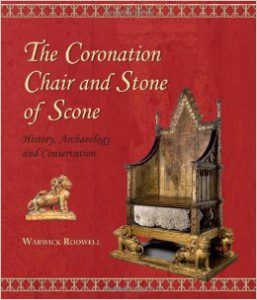 Warwick, Rodwell, with sections by Marie Louise Sauerberg, contributions by Ptolemy Dean and Eddie Smith, and foreword by the Dean of Westminster. 2013. “The Coronation Chair and Stone of Scone: History, Archaeology and Conservation”, Oxford and Oakville: Oxbow Books and the Dean and Chapter of Westminster, xv + 304 pp (hb). ISBN 978-1-78297-152-8, rrp £29.95.
Warwick, Rodwell, with sections by Marie Louise Sauerberg, contributions by Ptolemy Dean and Eddie Smith, and foreword by the Dean of Westminster. 2013. “The Coronation Chair and Stone of Scone: History, Archaeology and Conservation”, Oxford and Oakville: Oxbow Books and the Dean and Chapter of Westminster, xv + 304 pp (hb). ISBN 978-1-78297-152-8, rrp £29.95.
Warwick Rodwell and his colleagues have produced an extremely detailed study of two hugely important historic objects. The book’s cover may look a little dated but inside you will find a work of uncompromising detail whose pages are attractive and very well illustrated. It is clear that this book has been written by people who care greatly about the Coronation Chair and Stone of Scone.
Some readers may, as we did, find the sections of the book about the Stone of Scone to be the most interesting, as the Stone seems, perhaps, to be the more mysterious object. Of the two objects, it is surely the one with which is more culturally and politically charged, more historically dramatic, and more controversial. Historically dramatic because it was part of Edward I’s war loot taken from Scotland, and controversial because, for some at least, there is the issue of whether the Stone ‘belongs’ to England or Scotland, or the UK as a whole. There also remains the issue of whether the Stone, the majestic ‘Stone of Destiny’, is in fact a medieval fake which was handed over to Edward so that the real coronation stone of Scotland’s kings could remain hidden. The fact that Scotland never produced the real stone (which had they done so would have been a political masterstroke against England) says to us that there was no ‘real’ stone to produce. The real, sacred coronation Stone of Destiny was, surely, a prisoner in England, and all stories about England have being duped with a phoney coronation stone simply attempts to keep Scottish heads held high.
But can we be certain that this is the case? As theories they seem ultimately to be implausible, but that does not mean we should close our minds to a range of possibilities and scenarios.
The Coronation Chair and the Stone of Scone become in this book one object. The two objects, in Professor Rodwell’s opinion, have become fused into one through centuries of royal usage and tradition. Rodwell argues powerfully that it was wrong for the Stone to be returned to Scotland. He is surely right that politicians rather than historians were the driving force behind the Stone’s return. But is Rodwell right that the Chair and Stone have become one object for all time? Who says they can no longer be separated and allowed the chance to evolve into new futures and new symbolisms? It is on this question that nationalism, politics, academic history and museum conservation clash, and it is a question which may well have no perfect answer.
The book’s exceptional range of illustrations enables the reader to fully immerse themselves in these complex issues, and to reflect on what solutions might be found to the question of the Stone’s true home. Above all else, there is so much compelling technical analysis and uncompromising factual detail in this book that we feel sure that this will be the standard work on the subject of ‘stone and chair’, and their significance in the ancient act of coronation. Without doubt, this is a very useful book with significance and implications for many areas of academic enquiry.
Reviewed by Fergus Cannan-Braniff, Josh Barker and Theo Merchant (2016)
Fergus Cannan-Braniff worked with the European sculpture collection at the Victoria and Albert Museum and now teaches history, religion and geography. Josh Barker and Theo Merchant are students of history, philosophy and English.
